Getting Started with Every Day Counts Calendar Math: Grade 4
Step 1: (30 minutes)
If you are new to Every Day Counts, read the front matter (p. 5-9) in the Every Day Counts teacher’s guide and August/September (p. 16-17). This will help you get to know the EDC elements and how to set up for the start of school.
Step 2: (5 – ? minutes)
Examine your room set-up to find the best place to display Every Day Counts so that all students can see all the elements. A bulletin board is handy for pinning up the materials, but if such a board is not present or not in a good location for viewing, many teachers have been able to place the calendar and other elements on a wall, whiteboard, or chalkboard using tape or magnets. Some have even placed a science display board or sheet of foam core in the chalk tray to tape, or pin elements to using T pins. It is nice if you can gather the children up close to view the Calendar and other elements.
EDC Counting Tape – Day of School

Step 3: (25 min. prep) Begin 1st day of school or catch up to present Day of School
See T Guide, p. 23-24 and click on Samples – Photos and Questions 4 at edconline.net
Unroll and put up at least 15 feet of the blank Adding Machine Tape or sentence strips. The Counting Tape needn’t be in the same part of the room as the other elements on the board as long as everyone can see it.
Beginning with the number 1 on the first day of school, each day students come to school will be recorded on the tape. On even-numbered days place a heart marker (from the Every Day Counts Kit cardstock or from copies of TR 6: Multiple Markers from back of T Guide) to mark each multiple of 2. Some teachers find it easier to write the numbers on the tape prior to putting it up and then note the progress of the days in school by moving a sticky note with an arrow along to the next number on the tape each day (not in photo).
EDC Daily Depositor – Day of School
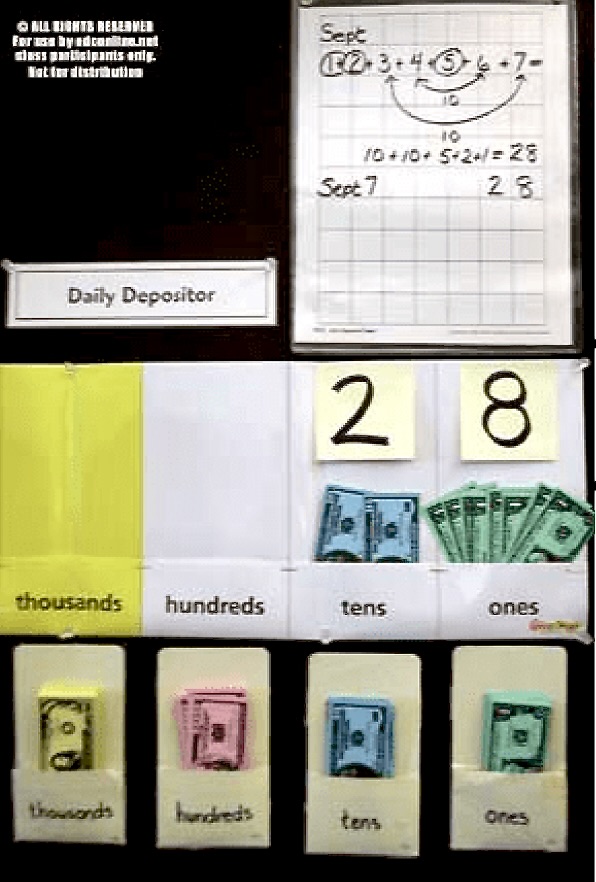
Step 4: (10 minutes prep)
See T. Guide, p. 21-22 and click on Samples – Photos and Questions 4 at edconline.net
Have ready to introduce the first of September, if your school year has started in August, or have ready to introduce on first school day in September. Locate the Daily Depositor background from the EDC Kit or use 3 sheets each of white, yellow, and green copy paper to create the pockets. Fold each paper the long way. Then fold up bottom 2 inches and staple on each side. Tape pockets together on back side to create place value pocket chart. Make 10 copies of TR 3: 1-inch squared paper, and place one nearby to record the results of each day’s withdrawal. Have students help cut apart the supply of play money bills from the Every Day Counts Kit, or from copies made of TR 2 from back of T Guide. Group them by denomination with rubber bands or keep them in pockets or snack ziplocks, displaying one denomination of bills below each pocket of the Depositor. Have Post-its handy to record the digit above each place value pocket naming the number of bills collected of that denomination.
EDC Calendar – Beginning of September or 1st Month of School
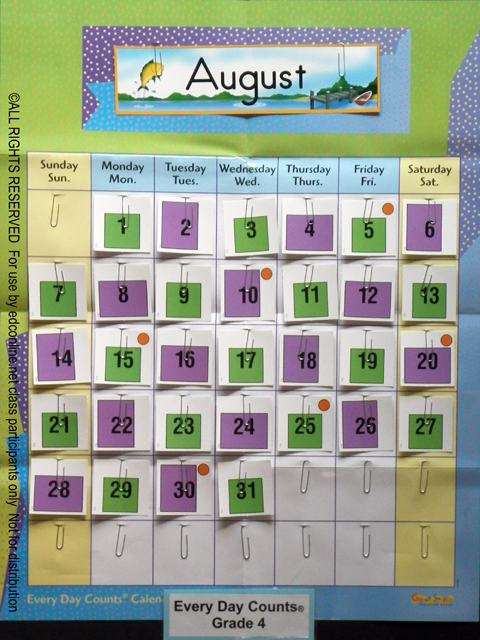
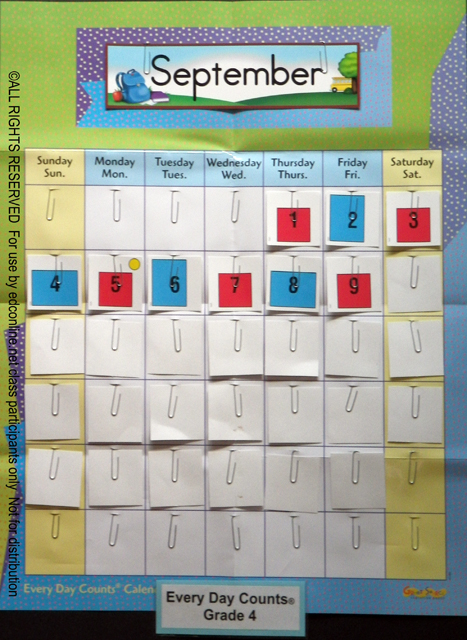
Step 5: (25 minutes prep) No lamination needed. Begin the 1st of September or catch it up to present day in September.
Note: If you begin school in August or are year round, you may choose to use the August pieces for your first month of school. August and September reveal the same basic pattern.
See T. Guide, p. 18-20 and click on Samples Photos and Questions 4 at edconline.net
Prepare Calendar by creating slits on slit marks using an Exacto knife or box cutter and placing a paper clip in each slit. Pull out the three sheets of Calendar pieces for the month and display them on the Calendar from the 1st up to the present day of the month. After the present date, place the remaining pieces face down under each paper clip (so they can be turned over one at a time on each new day of the month).
EDC Coin Counter
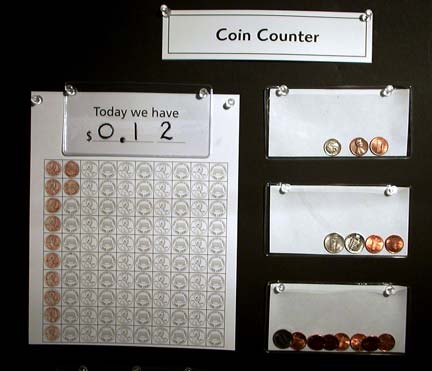
Step 6: (10 min. prep)
See T. Guide, p. 26-27, and click on Samples – Photos and Questions 4 at edconline.net
Begin early in the school year to show different coin combinations equal in cents to the number of Day of School. Use three small clear pockets from the Every Day Counts Kit attached one above the other to the bulletin board. Place a copy of the 100 Penny Grid (TR 9) near the Coin Counter. Laminate (if using brown overhead pen) or place in a sheet protector (if using a brown dry erase pen). Place a supply of real coins (15 pennies, 10 nickels, 10 dimes) in re-sealable baggie nearby.
EDC Graph – Probability Experiment
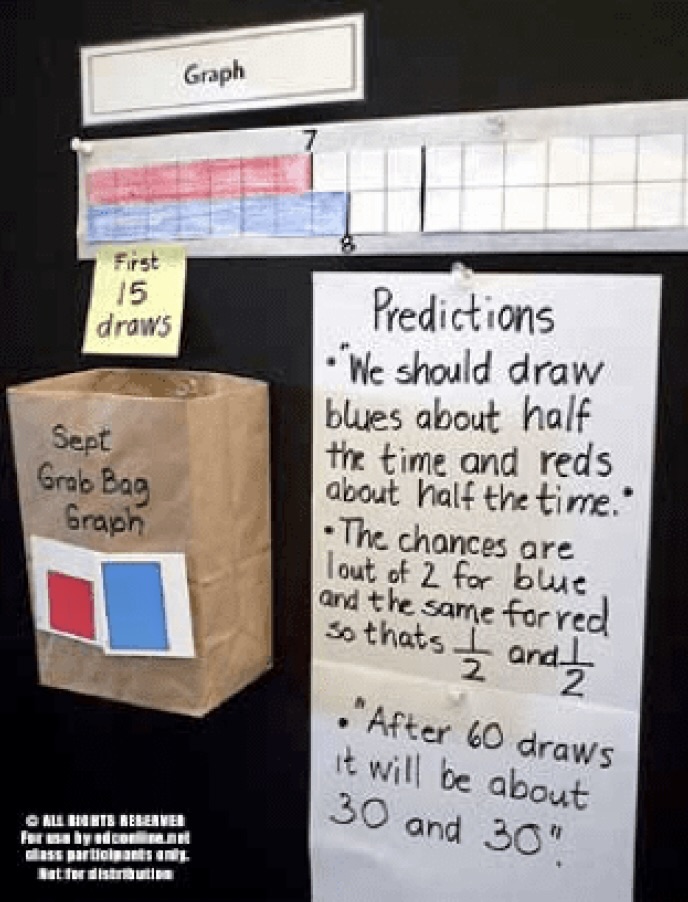
Step 7: (10 min. prep)
See T. Guide, p. 28-29, and click on Samples – Photos and Questions 4 at edconline.net
Copy, cut, and tape together grid paper (TR 3 or 19) to create a graph 2 spaces wide by 40 spaces long for recording the results of this draw and replace experiment. Find the 1 red square and 1 blue rectangle (without numbers) from the September Calendar Pieces. A lunch sack or bag or box can be used to hold the pieces.
You are done! This is everything you will need to begin sharing the September elements with your students. September requires the greatest preparation time. Next month you will continue to use these materials and add in a couple of new items. By November all the elements will be introduced reducing preparation time for the remaining months.
To see Question Starter Cards click on SAMPLES:
The note cards you see accompanying each photo with starter questions can be printed as PDF files, cut apart, and mounted on 5×7 note cards for your easy reference during Every Day Counts discussions. During the month, please add to your cards questions of your own design or questions from your reading that you want to remember to try out. Some questions should aim at simply having students examine the data and describe what they see. Others questions should require students to engage in higher level thinking, requiring them to reason, analyze, make predictions, and form generalizations about concepts being explored each month.

